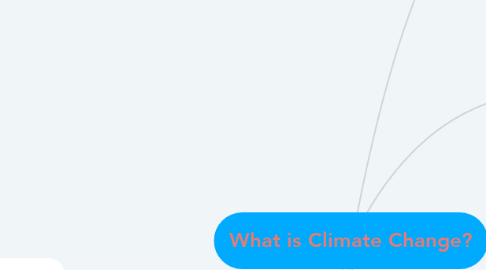
1. Is defined as:
1.1. Weather patters changing over time
1.1.1. Characterized in terms of:
1.1.1.1. Extremes
1.1.1.2. Averages
1.1.1.3. Degree of variability
1.1.1.4. Temperature
1.1.1.5. Pressure
1.1.1.6. Humidity
1.1.1.7. Rainfall
1.2. Environmental Changes
1.2.1. Animals can adapt to climate change in one of the three ways: shift, adjust via phenotypic plasticity, adapt, or become extinct.
2. People try to Stop it by:
2.1. Reducing, Re-using, Recycling
2.2. Reducing the use of fossil fuels
2.2.1. Via
2.2.1.1. Solar Panels
2.3. Reducing Meat Intake
2.4. Unplugging devices
2.5. Utilizing Public Transportation
3. It is affected by:
3.1. Geographic Context
3.2. The Greenhouse Effect
3.3. Albedo
3.4. Solar Irradiance
3.5. Atmospheric and Oceanic Circulations
3.5.1. Control distribution of:
3.5.1.1. Precipitation
3.5.2. Causes:
3.5.2.1. Garbage Patches
3.5.2.1.1. Are Defined As
3.5.2.2. Redistribution of heat
3.5.2.2.1. Modifies:
3.5.3. Are Disrupted By:
3.5.3.1. Plastics Polluting the Oceans
3.5.3.1.1. Microplastics
3.5.3.2. Depletion of the Ozone Layer
3.5.3.2.1. Caused by
3.5.4. Thermohaline Circulations
3.5.4.1. Are Defined as:
3.5.4.1.1. the component of general oceanic circulation controlled by horizontal differences in temperature and salinity
3.6. Air Pollution
3.6.1. Occurs when:
3.6.1.1. Pollutants such as smoke or dust particles are released into the environment.
3.6.1.1.1. Types of Air Pollution:
3.6.1.2. Can Cause:
3.6.1.2.1. Heart Disease
3.6.1.2.2. Lung Cancer
3.6.2. Is Affected by:
3.6.2.1. Temperature
3.6.2.2. Pressure
3.6.2.3. Humidity
3.6.2.4. Rainfall
3.7. Food Security, Safety, Water Pollution
3.7.1. Water pollution occurs when harmful substances pollute a stream, river, lake, ocean, aquifer, or other body of water, decreasing water quality and making it toxic to humans or the environment.
3.7.1.1. Surface Runoff
3.7.2. A food hazard can be microbiological, chemical or physical and can include bacteria, viruses or pesticide residues.
3.7.3. Food security is a measure of the availability of food and individuals' ability to access it. There are many factors
4. Is Studied by:
4.1. Geological and Biological proxies
4.1.1. Measure Indirectly:
4.1.1.1. Past Climate
4.2. Instruments
4.2.1. Measure Indirectly:
4.2.1.1. the current state of the atmosphere
4.2.1.1.1. Over:
5. Political Factors:
5.1. Government Policy
5.1.1. Federal Policy
5.1.1.1. International Law
5.1.1.2. Congress
5.1.2. State and Local Policy
5.2. Media
5.2.1. Informs the public on whether to support a policy or not
5.3. Trading Policy
5.4. The Montreal Protocol
5.4.1. Is Defined as:
5.4.1.1. An international treaty designed to protect the ozone layer by eliminating substances that deplete the ozone layer.
5.4.1.1.1. It was signed on September 16th, 1987.
5.5. Sustainable Development
5.5.1. Is defined as:
5.5.1.1. Economic development that meets the needs of the present without compromising the ability of future generations to meet their needs.
